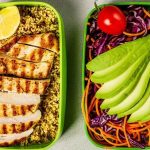Introduction
In recent years, the demand for gluten-free food has skyrocketed as more people are becoming aware of gluten-related sensitivities and conditions, such as celiac disease. Gluten-free diets have transcended their niche status and are now embraced by a diverse range of individuals seeking healthier alternatives or simply wanting to try something new. In this article, we will embark on a culinary journey to discover the delectable world of gluten-free cuisine, exploring a variety of ingredients, techniques, and recipes that will tantalize your taste buds and cater to your dietary needs.
Understanding Gluten and Gluten Sensitivities
Before diving into the realm of gluten-free cuisine, it’s essential to understand what gluten is and who might benefit from a gluten-free diet. Gluten is a protein found in wheat, barley, rye, and related grains. For individuals with celiac disease, consuming gluten triggers an immune response that damages the small intestine. Additionally, some people may experience gluten sensitivities or intolerances, causing adverse digestive symptoms and discomfort. Adopting a gluten-free diet can alleviate these issues and promote overall well-being.
Exploring Gluten-Free Ingredients
Contrary to popular belief, a gluten-free diet is not limited to a bland and unexciting array of foods. In fact, numerous naturally gluten-free ingredients are both nutritious and delicious. Let’s delve into some of the key ingredients that form the foundation of gluten-free cooking:
Whole Grains: Quinoa, rice, millet, buckwheat, and amaranth are just a few examples of gluten-free whole grains that can be incorporated into a range of dishes, from pilafs and salads to porridges and baked goods.
Legumes and Pulses: Lentils, chickpeas, black beans, and other legumes are excellent sources of protein, fiber, and essential nutrients. They can be transformed into hearty soups, stews, veggie burgers, and even gluten-free pastas.
Nut Flours: Almond flour, coconut flour, and hazelnut flour are fantastic alternatives to traditional wheat flour when it comes to baking. These nut-based flours add a rich flavor and moist texture to cakes, cookies, and bread.
Alternative Starches: Arrowroot, tapioca, and potato starch are frequently used as thickening agents or to create light and crispy coatings for fried foods. They are valuable assets in gluten-free cooking.
Fresh Fruits and Vegetables: Naturally gluten-free, fruits and vegetables are the cornerstone of a healthy gluten-free diet. They add vibrant colors, flavors, and nutritional value to any meal.
Mastering Gluten-Free Cooking Techniques
Adapting to gluten-free cooking techniques may seem daunting at first, but with a little practice, it becomes second nature. Here are some essential tips to keep in mind:
Read Labels: When purchasing packaged foods, always check the labels for hidden sources of gluten, such as modified food starch, malt, or barley extracts.
Cross-Contamination: Prevent cross-contamination by using separate utensils, cutting boards, and baking equipment for gluten-free ingredients.
Experiment with Flours: Explore the diverse world of gluten-free flours and experiment with combinations to achieve the desired texture and flavor in your dishes.
Binders and Thickeners: Xanthan gum and guar gum are commonly used as binders and thickeners in gluten-free recipes, mimicking the elasticity and structure of gluten.
Embrace Alternative Baking: Gluten-free baking requires adjustments in moisture content and leavening agents. Familiarize yourself with the nuances of gluten-free baking to achieve excellent results.
Delicious Gluten-Free Recipes to Try:
Quinoa-stuffed Bell Peppers
Chickpea Flour Pancakes
Zucchini Noodles with Pesto
Flourless Chocolate Cake
Gluten-Free Pizza with Cauliflower Crust
| Category | Gluten-Free Foods | Tips |
|---|---|---|
| Grains and Cereals | Quinoa, rice, corn, millet, sorghum, buckwheat | Check labels for hidden gluten in processed grains |
| Proteins | Chicken, turkey, fish, eggs, tofu, legumes | Be cautious of breaded or marinated options |
| Fruits and Vegetables | Apples, bananas, berries, carrots, spinach | Fresh and unprocessed fruits and veggies are safe |
| Dairy and Alternatives | Milk, yogurt, cheese (check labels) | Choose lactose-free options if sensitive |
| Nuts and Seeds | Almonds, walnuts, chia seeds, flaxseeds | Avoid cross-contamination in bulk bins |
| Snacks and Treats | Popcorn, gluten-free granola, rice cakes | Look for dedicated gluten-free snack options |
| Condiments | Mustard, ketchup, salsa, olive oil | Verify soy sauce and other condiments are GF |
| Beverages | Water, coffee, tea, 100% fruit juice, gluten-free beer | Read labels, especially in flavored beverages |
| Baking Ingredients | Gluten-free flour, almond flour, coconut flour | Use certified gluten-free products for baking |
Remember to always read labels carefully, as gluten can hide in unexpected places. Additionally, be cautious when dining out, and communicate your dietary needs to restaurant staff to ensure a safe dining experience.
Conclusion
Embracing a gluten-free lifestyle doesn’t mean sacrificing taste or variety. With an abundance of gluten-free ingredients, innovative cooking techniques, and a dash of culinary creativity, you can embark on a delightful gastronomic journey, exploring the vast world of gluten-free cuisine. So, get ready to savor the flavors and indulge in the pleasures of a gluten-free lifestyle!

















